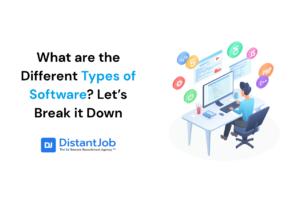Beating the average attrition rate in tech (from 13.2 to 18.3%) might seem tough, but it isn’t necessarily, especially if you focus on what truly matters to your developers. By understanding how your developers’ brains and minds work—their core drivers, motivators, and demotivators—and implementing strategies such as challenging their intellect, giving them autonomy and creative freedom, and rewarding them for their wins, among others we’ll share below, can significantly increase retention and lower turnover successfully.
Actually, studies reveal that 70% of employees are more likely to stay in roles where they feel their work is meaningful, while 65% of tech professionals prioritize remote work opportunities that offer flexibility and autonomy.
These insights highlight how giving developers the freedom and mental stimulation they crave is key to keeping them around. For those working on cutting-edge tech, the opportunity to learn, own their projects, and bring their creativity to the table is critical.
Without these opportunities, developers often feel stagnant and start seeking growth elsewhere—resulting in higher turnover rate for your business.
But retaining talent is more than that. You need to understand their mindset so you can offer them what they really need and want so you can ensure they stay with you long-term.
Lucky for you, we’ll go beyond the surface-level fixes to uncover what truly keeps developers loyal and invested in their teams for the long haul, and 7 strategies to keep them from leaving.
7 Ways to Reduce the Attrition Rate in Your Tech Company
Reducing and altogether beating the attrition rate in your tech company and making sure your IT talent sticks around for the long-term requires implementing some strategies that address their specific needs and drives, such as empowering them to be autonomous, allowing them flexibility, and creating a space where they feel safe to take risks, among others. By focusing on these areas, you can significantly increase dev engagement and retention and lower turnover.
To help you do that, here are 7 tested and tried ways to retain your top developers and keep them from quitting:
1. Challenge Your Developers’ Intellect
To keep your best developers engaged and invested thus preventing them from losing their spark and eventually leaving, you need to keep them mentally stimulated. So push their creative boundaries by getting them to work on experimental projects or innovation labs and by letting them join open-source groups. Also, set up rotation programs so they can work in different parts of the company or on various projects. And, to make sure this all works, give them the right tools and platforms, such as online whiteboards and software that allows them to work on code together in real-time.
2. Assign Purposeful Technical Work
When your tech talent works on projects that matter, that have real impact, they feel a sense of achievement and satisfaction that keeps them involved and engaged long-term thus lowering turnover. So give your team projects that align with your company’s mission and make it a point to show how they help users. Besides, don’t just delegate projects to whoever you think is best for the task. Instead, give your team members a chance to pick the projects they feel match their interests and skills, the ones they really want to contribute to, and give regular feedback on how their contributions make a difference.
3. Build a Culture that Values and Drives Upskilling and Reskilling
According to Korn Ferry’s latest Workforce Survey, a significant majority (67% actually) of professionals would be willing to stick around at their current job if offered with opportunities to upskill quickly. And here’s the kicker: even if they hated it. This stat just goes to show how really essential it is to invest in your employees’ L&D (Learning & Development) if you want to beat the average tech attrition rate. To do so, give them access to high-level training, workshops, and industry events like AWS re:Invent or Google Cloud Next to help them expand their expertise. Also, lay out clear career progression paths with specific criteria for promotions to keep them motivated for investing in their growth themselves.
4. Empower Autonomy and Allow for Flexibility
To retain your top tech talent, autonomy and flexibility are key. Autonomy means allowing them to make decisions about their projects, about how to approach tasks and solve problems while flexibility means allowing them the freedom to make choices when it comes to their schedule, their synchronous hours, where they work (if in office, hybridly, or remotely). And the thing is: too much control is a big turn off for employees in every industry, including tech. In fact, studies show that 70% of workers think about leaving due to micromanagement, and 30% actually do. So, you must give them the power to make important choices about their projects and how they go about them.
Besides, since with an increase of 146% in remote job applications and a decrease of 46% in remote job postings and with 75% actually confirming that the flexibility to work not just from anywhere they want but also whenever they want is vital, you have to make sure these desires are being supported. So give them the freedom to choose a work setting and style that suits them, letting them be in charge of when and where they work, be it a hybrid or a remote model and flexible hours.
5. Celebrate Coders’ Successes with Public Recognition
Publicly acknowledging and praising their hard work—be it in team meetings or an internal newsletters—shows their importance to the company and points out the real results of their efforts, ultimately resulting in higher retention rates in your IT team. And so, to effectively celebrate their wins, create structured recognition programs such as monthly or quarterly awards for top performance and innovative solutions, and also foster a culture of casual recognition by kicking off meetings with a “high five” section. You can use peer-to-peer recognition platforms like Bonusly and Kudos as well, where team members can show their appreciation in real time, and where, depending on the system you choose, these boosts or points can even be exchanged for rewards or perks.
6. Create a Safe Environment that Encourages Risk-Taking
In order to create a safe space where risk-taking is encouraged and supported, start by building trust within your teams. To do that, set up regular meetings where your developers can share their ideas and take accountability for their mistakes without worrying about consequences or repercussions. Set the tone by demonstrating vulnerability and by showing the focus is on learning and growing rather than pointing fingers. Besides, implement lessons learned sessions after a project ends, where everyone involved meets to talk about how things went, and encourage your programmers to keep their own document with these insights. Make it a point to give helpful and constructive feedback that focuses on growth and improvement and to promote a culture of transparency by sharing company goals, project updates, and team performance.
7. Provide Satisfying Compensation and Long-Term Perks
According to recent research, about 38% of employees feel their salary and benefits don’t match their output and performance. And when over a ⅓ of your company feels that way, turnover is just around the corner. It’s clear that while competitive salaries attract great professionals, retaining them takes more than that. So integrate performance based-incentives and stepped bonus plans that not only match bonuses with how well people and teams do, but also to how hard and important their work is. Reward them for staying by tying rewards to their tenure with milestones like bonuses on their 2-year anniversary or trips on their 5-year anniversary. And also reward them for new solutions they come up with or big improvements, and create an even stronger sense of ownership by offering them stock options or shares in the company, motivating them to consistently perform better (as your company will be theirs as well). Besides, you can set up vesting schedules for equity awards and profit-sharing programs.
Practical Exercises for Leaders to Put Retention Strategies into Action
Now that we have covered the 7 ways you can reduce the attrition rate in your company, let’s dive a bit deeper into the how and explore practical exercises you can implement to make sure you retain your top developers for the long haul.
1. Spark Creativity Through Cross-Department Collaboration
Get your developers to join other departments’ strategy or planning meetings—whether it’s marketing brainstorming campaign tactics, finance reviewing budgeting, or product leads mapping out future releases. When your tech teams take part in non-technical talks, your company can take advantage of their insights, since their fresh perspective and technical minds can spot ways to improve processes, come up with new ideas, and even share what’s possible technically-wise.
You can even try short ‘rotation programs’ where your programmers can work with different teams for a period of time, so they can get a better understanding of your business as a whole, while keeping their day-to-day experience interesting and fun, therefore keeping them engaged and less likely to attrite.
2. Connect their Work to Meaningful Results
Show your tech team the direct connection among each project they take on, the company’s mission, and their real impact on users. For example, when working on a new feature for an app, don’t just brief them on the technical part, but rather highlight how it’ll impact users.
Also let them choose projects that really match their interests and skills and after each launch, hold a quick “Impact Review” session where you can share user feedback and business gains. When you do that, you combine purpose, personal choice, and solid results, which is a guaranteed way to keep your programmers motivated and ready for any new challenges as your business grows.
3. Help Them Grow Their Skills
Hold quarterly 1:1s where you and your IT talent can create a personalized growth plan, which can include taking a certification course, attending a special event (like AWS re:Invent or Google Cloud Next), or mentoring junior members of the team. Also, set clear goals and a budget for these plans, and reassess progress in the next meeting. By doing so, you not only support employee development, you also align their skills with future needs, while making sure they stay long term, thus reducing turnover.
4. Boost Self-Reliance and Work Flexibility
Create a policy that allows for flexible hours and/or remote work days. For example, give your developers the option to work from home a few days of the week and set their core working hours. By doing so, you show you trust their independence and prevent burnout. As a result, they feel more in charge, more satisfied, and a lot less likely to look for opportunities elsewhere.
5. Start Formal and Casual Recognition Programs
Honor big wins such as hitting revenue targets or launching a new product and reward employee anniversaries and promotions with thoughtful gifts, small celebrations, and shout-outs. Besides, adopt a peer-recognition tool such as Bonusly and Kudos so coworkers can share spontaneous appreciation to one another. In the end, this mix of planned and impromptu recognition enhances your company culture and lowers attrition over time.
6. Create a Safe Space for New Ideas
Run monthly “Brainstorm & Debrief” sessions where you can make room for your engineers to suggest bold and untried ideas and talk about recent challenges and obstacles with no fear of criticism or blame. Start things off by making it clear that the goal is to learn and improve, not to point fingers, so they feel encouraged to share fresh perspectives. Also share company goals, project updates, and team performance in your weekly, in an internal newsletter, or share these updates on your group chat, in order to promote a culture of transparency and get everyone involved and energized about their work, which ultimately also reduces their chances of quitting.
7. Offer Stock Options Instead of Only Cash
Give your top performers 1-3% ownership in the company, and seniors 5-10%, rather than just compensating them monetarily. Also, create a four-year vesting plan with a one-year cliff, so they only earn anything until they’ve stayed with your company for at least a year. This is a perfect retention strategy for startups with tight budgets but growth potential, as it directly ties your employees’ success to the company’s success, making them want to work harder and stay longer.
Conclusion
As you can see, while beating the average attrition rate in tech can seem complex, it doesn’t have to be that way.
By implementing the strategies shared in this article, you’ll see your turnover rates dropping and your tech team loyalty rising.
So make sure to motivate their intellect to problem solve, give them creative freedom, encourage ownership and innovation, celebrate their achievements publicly and reward them for their wins all within a safe environment, and finally to offer compensation that really matches their contributions, as it’ll definitely pay off.
And if you want to ensure that your turnover rates are the lowest possible, hiring right makes all the difference. When you hire the perfect talent that not only has the skills you need but is a perfect cultural fit to your company, they’re definitely much more likely to stick around. And we can help you do that. With our expertise in remote recruiting for top talent for US businesses, we can find you the right developers fast and affordably.
Reach out now and we’ll tell you how.





